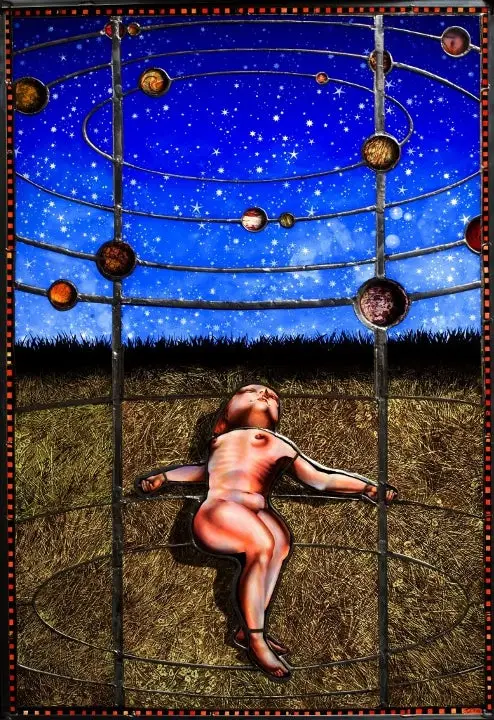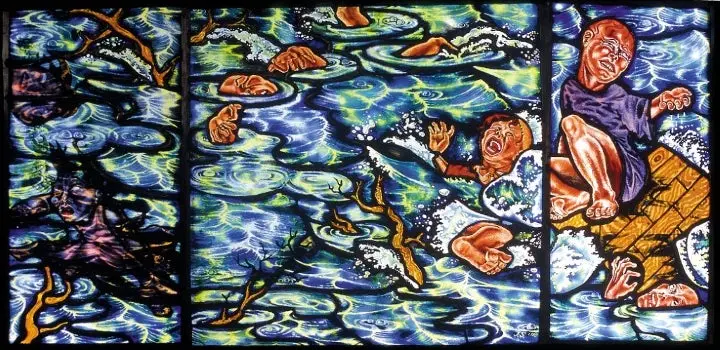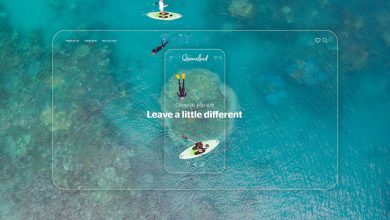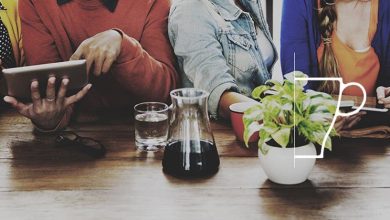Judith’s Schaechter’s multifaceted approach to self-expression

Image source: Detail of “Feral Child” (2012), Judith Schaechter.
Evidence of multimedia artist Judith Schaechter’s decades-long relationship with computer-assisted design tools might be hard to pinpoint.
Her stained-glass compositions are ornate, wildly imaginative, and intricately hand-detailed. Where the physical ends and the digital begins only adds to the dreamlike, ethereal quality of her work—an update to the old-world conventions of stained glass. Schaechter’s blend of this traditional art form with modern, contemporary themes and subjects recontextualizes both, part of a large and growing design trend Adobe Stock has termed “Austere Romanticism.”
For some artists, self-expression may manifest as a one-to-one act of self-portraiture, but for Schaechter, there is a desire to express the deeply personal by way of the universal.
Image source: “You Are Here” (2008), Judith Schaechter.
“You need to figure out what it is about yourself that is completely unique, and also what makes your work incredibly universal” says Schaechter.
What makes Schaechter’s work stand out is her continual experimentation within a medium that has its roots in centuries-old Medieval and Renaissance art. She also draws upon her lifelong relationship with specific paintings made throughout art history—the influence of which is evident, even through the layers of abstraction Schaechter weaves into her compelling, contemporary glass works.
The personalities Schaechter renders in her glasswork are a series of beautiful, gripping, and complicated figures in equally complicated situations. Lone subjects are almost always women caught in acts of self-awareness, clandestine reflection, or obscure ritual. Her larger works are often Boschian scenarios of revelry and chaos, with a wide spectrum of characters, activities, and attitudes.
Image source: “Caught in a Flood” (1990), Judith Schaechter.
From the physical to Photoshop
It seems counterintuitive to imagine that Schaechter’s process, which begins with hand-drawn sketches and ends in hours of meticulous etching and filing of colored glass, would have anything to do with contemporary technology—and, for many years, it didn’t. But in 2000, already a couple of decades into her art career, Schaechter revolutionized her compositional process as her relationship with technology began to change.
“There used to be a Xerox place not far from where I lived at the time, called ‘Can-Do,’ and I would haul my drawings to Can-Do, and I would Xerox them in all different sizes,” says Schaechter. “My Xerox bill was getting to be like hundreds of dollars a month, or something insane like that.” Schaechter had previously tried her hand at tech tools via a secondhand Apple 2, which required hand-coding in order to operate basic programs. It did not go as planned.
“I threw it out the window,” Schaechter says. “I did not get the memo about operating systems becoming user-friendly—I just wasn’t paying attention—but I had decided that I needed to buy a Xerox machine, because this was crazy. So, my little pea brain was sort of grinding around, and I thought, maybe if I get a computer, I can organize my mailing list on it. And, basically, a computer—it was the same price as buying a Xerox machine, so I thought, all right, I’ll get the computer, and I got a scanner.”
Image source: “Still Life with Bankrobber” (1996), Judith Schaechter.
Around that time, Schaechter read an article by illustrator Mark Ryden, in which he discussed the benefits of scanning in his sketches. Ryden was then able to “try out umpteen million layouts in one afternoon by essentially just moving elements around in a Photoshop document,” recalls Schaechter. “And I was like, ‘Ah! Yes! That’s what I want to do!’ And that’s now what I do.”
She started with the abbreviated version of Photoshop that came with her scanner, and the program provided an immediate revelation.
“I felt like Photoshop was an old friend,” says Schaechter. “I am the person who pushes every button—so first I destroyed everything, and then I had to fix everything.” As a result, Schaechter quickly incorporated Photoshop into her artistic workflow.
“I’ll tell you what, I really love Adobe Photoshop—it changed my whole way of thinking about art in a very, very positive way,” she says. “I always feel bad for people who are intimidated by it. It’s incredibly user-friendly if you’re an artist. I feel like it must have been made by artists for artists.”
Image source: “Child Bride” (2001), Judith Schaechter.
Art in life — and life, in art
The balance between specificity and universality in Schaechter’s work strikes at the core of the vulnerability surrounding the visibility – or invisibility – of the female form, especially as flawed or aging.
“I’ve struggled with my body image, as have many, many, many people before me,” says Schaechter, “and I think that comes out in my work.” Schaechter’s figures often have visible veins beneath the skin or exaggerated features—an emphasis on natural aspects of the body that women are often pressured to conceal—and she describes them as an effort to express the discrepancy between “what we see and what we think about human bodies.”
Schaechter’s subjects often seem caught in a struggle between their own sanctity of self and the demands of greater, outside forces acting upon them.
“They’re not me,” Schaechter says of her figures, “they’re like the proxy, doll version of me, and I want them to be better than me, and more beautiful than me, to compensate for my body and face dysmorphia.
“But I can’t make them too pretty,” she laughs, “because then I can’t identify with them anymore!”
Source : Adobe












